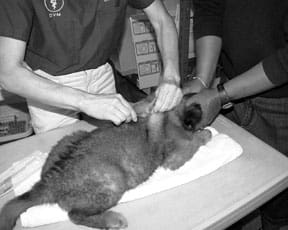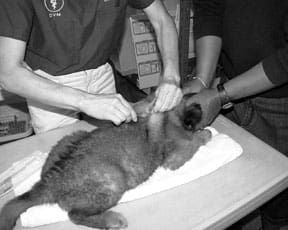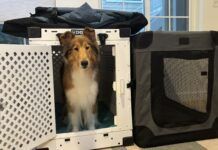We’ve all heard at least one tragic story involving a lost dog and a disconsolate owner. We’ve all seen a lost dog scared witless, running down a street with that classic lost dog expression, almost blind with fear.
A lost dog’s chances of finding his way back to his concerned owner are vastly improved if he’s wearing a collar and identification. People may try harder to catch a stray dog who is wearing a collar and tags; they may feel he’s less likely to be abandoned and more likely to be lost. A collar gives a samaritan something to reach for. And, obviously, the identification makes it ridiculously easy for the owner to be immediately notified and summoned to reclaim his errant friend.
Sadly, there are thousands of dogs lost each year who are not wearing a collar and ID, and too many of them are unable to ever return to their homes. The American Humane Association estimates that only about 15 percent of lost dogs and 2 percent of lost cats ever find their way back from shelters to their original owners. Implanted microchips can improve that sad statistic.
Theoretically near-perfect
A microchip is a tiny transponder, coded to display a unique identification number capable of being read by a hand-held scanner. The transponder is embedded in a sealed glass or bioplastic tube, often described as the size of a grain of rice – long-grain rice, anyway. (The tubes are 2mm x 11mm.)
The chip does not contain a battery or any other technology that can wear out; it draws power from and responds only to a scanner held fairly close to the dog and tuned to the correct frequency. The rest of the time, it is completely inert. The chips are implanted under a dog’s skin above his shoulders, with a pre-loaded, sterile syringe and a large-gauge needle. No anesthetic is required, and dogs generally react little more than to a regular vaccination injection.
The owner of the implanted dog then registers the chip with the manufacturer, linking her name and contact information, including numbers for the dog’s veterinarian and an alternate contact person.
Shelters scan every dog brought to their facilities. The scanner reads the chip, a call to the chip maker’s registry locates the owner’s name and contact information, and within minutes, a call is placed and the owner receives the joyous news, “We have your dog.”
Reality bites, sometimes

288
That’s exactly the way the system works – sometimes. The companies that provide micro-chips and chipping services toss around high numbers to promote the technology; for example, one company reports more than 200,000 pets reunited with their owners so far. These numbers are cause for celebration, and definitely a reason to embrace and support the practice.
Unfortunately, there are some significant problems that prevent the concept from working perfectly all the time:
• Competing microchip manufacturers have created and promoted incompatible technology – scanners that can’t read every chip, and chips that can be read only by certain scanners.
• Not all shelters have scanners. (And so it follows that not all shelters have all scanners.)
• Not all shelters that have scanners scan every dog who gets brought in. Overworked shelter staff may be ill-equipped or dis-inclined to scan a dog that is defensive, or seems aggressive or dangerous.
• Scanners can sometimes fail to read or even detect the presence of a compatible chip, whether due to a technology malfunction or operator error.
• In the early days of microchipping, the implants sometimes “migrated,” or moved to a place where they couldn’t be detected or weren’t detected because the person scanning the dog didn’t expect the chip’s location to be so far from the norm.
This is actually a former problem. Manufacturers say chips now are made with a special coating that, once in contact with body fluids and subcutaneous tissue, helps the body to form a layer of connective tissue around the chip, holding it in place.
• Owners may fail to register their dog’s microchip, or fail to update the registry with current information after they move.
• There are several competing chip registries, which can potentially delay notification of an owner.
Still worthwhile as a back-up
Despite all the potential problems, the fact remains that thousands upon thousands of dogs do get identified and recovered, thanks to their microchip implants. There have been reports in the media of dogs and cats who were found hundreds and even thousands of miles away from their original owners. There have been pets who were identified and brought back to their original owners as much as a decade after being lost!
These reunions, between collarless, tagless pets and their owners, would simply not be possible without microchip technology, imperfect as it is.
And, fortunately, there are a number of things that a dog owner can do to reduce the number of potential problems that could otherwise hinder the effectiveness of the microchip identification system.
What you must do
First, keep a collar and current ID on your dog. Then, because bizarre things happen, have your dog microchipped, in case he becomes lost and separated from his collar.
Before you have a microchip implanted in your dog, do some research in your community. Call all the veterinary hospitals in your area and ask if they implant microchips, and if so, which type? Then call every animal shelter in your area and ask them the same questions. Don’t settle for ambiguous answers; ask to be transferred to one of the staff members who actually scans incoming pets. Find out whether they check for 125- and/or 134.2-kHz chips (see “A Brief History of the Chip Wars,” previous page), and if so, how? Do they use more than one scanner? Or do they have a forward and backward scanner?
If you are extremely fortunate, the animal shelters in your community have and reliably use either a forward and backward scanner, or both types of scanners. (We suggest a letter-writing campaign to urge your shelter to obtain and use an ISO scanner that can read or at least detect all chips.) The next best scenario is the community in which only one type of chip is sold and its corresponding scanner is used reliably by all the area animal shelters.
If your local shelters do not regularly scan for microchips, or do not scan for all the chips that are distributed by vets, clinics, and other shelters in your area – consider having your dog tattooed in addition to or instead of microchipping. Two lines of defense are always better than one.





